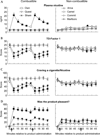Evaluating the acute effects of oral, non-combustible potential reduced exposure products marketed to smokers
- PMID: 19346218
- PMCID: PMC3207996
- DOI: 10.1136/tc.2008.028993
Evaluating the acute effects of oral, non-combustible potential reduced exposure products marketed to smokers
Abstract
Background: Non-combustible potential reduced exposure products (PREPs; eg, Star Scientific's Ariva; a variety of other smokeless tobacco products) are marketed to reduce the harm associated with smoking. This marketing occurs despite an absence of objective data concerning the toxicant exposure and effects of these PREPs. Methods used to examine combustible PREPs were adapted to assess the acute effects of non-combustible PREPs for smokers.
Methods: 28 overnight abstinent cigarette smokers (17 men, 14 non-white) each completed seven, Latin-squared ordered, approximately 2.5 h laboratory sessions that differed by product administered: Ariva, Marlboro Snus (Philip Morris, USA), Camel Snus (RJ Reynolds, Winston-Salem, North Carolina, USA), Commit nicotine lozenge (GlaxoSmithKline; 2 mg), own brand cigarettes, Quest cigarettes (Vector Tobacco; delivers very low levels of nicotine) and sham smoking (ie, puffing on an unlit cigarette). In each session, the product was administered twice (separated by 60 min), and plasma nicotine levels, expired air CO and subjective effects were assessed regularly.
Results: Non-combustible products delivered less nicotine than own brand cigarettes, did not expose smokers to CO and failed to suppress tobacco abstinence symptoms as effectively as combustible products.
Conclusions: While decreased toxicant exposure is a potential indicator of harm reduction potential, a failure to suppress abstinence symptoms suggests that currently marketed non-combustible PREPs may not be a viable harm reduction strategy for US smokers. This study demonstrates how clinical laboratory methods can be used to evaluate the short-term effects of non-combustible PREPs for smokers.
Figures

References
-
- Lakier JB. Smoking and cardiovascular disease. Am J Med. 1992;93:8S–12S. - PubMed
-
- Hoffmann D, Hoffmann I. Tobacco consumption and lung cancer. Cancer Treat Res. 1995;72:1–42. - PubMed
-
- Critchley J, Capewell S. Smoking cessation for the secondary prevention of coronary heart disease. Cochrane Database Syst Rev. 2004;4:CD003041. - PubMed
-
- Schroeder SA. What to do with a patient who smokes. JAMA. 2005;294:482–487. - PubMed
-
- Benowitz NL. Neurobiology of nicotine addiction: implications for smoking cessation treatment. Am J Med. 2008;121:S3–S10. - PubMed
Publication types
MeSH terms
Substances
Grants and funding
LinkOut - more resources
Full Text Sources
Medical
